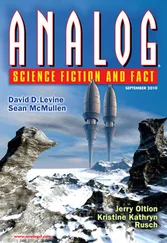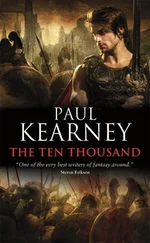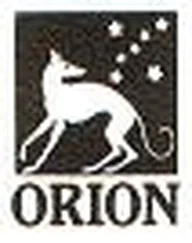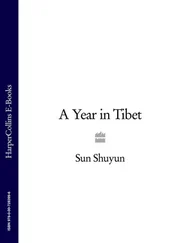We reached the valley quickly. The mountain is stark, barren and bald. I could hear the sound of water gushing at the bottom of the gully although I could not see it. We were picking our way over a rocky road more suitable for goats than cars when suddenly it opened up to a wide space where half a dozen cars were parked. I rushed to get out; Fat Ma made no move.
‘I think I’ll wait for you here,’ he said. ‘The thing with Bezeklik is: if you don’t see it, you will regret it; after you’ve seen it, you’ll regret it even more. Go and find out for yourself.’
The caves were indeed a terrible letdown, even with Fat Ma’s warning. Gone were the fantastic murals, the pictures of which I so loved. The majority of the fifty-odd caves were barred over, like a zoo without animals; the ‘good’ ones were virtually bare, just here and there a faint trace of a mural, a featureless Buddha, or a broken flower petal. All I could see clearly were the chisel marks made by the German explorer Albert von Le Coq and his colleagues as they divested the caves of their treasures to take them back to Europe.
In the nineteenth and early twentieth century Bezeklik and other treasures of Xinjiang became the target of frenzied international exploration. This was the age of adventure. As one scholar put it, ‘No heroes stood taller in the Victorian pantheon than explorers. These explorers were the dashing film stars of the imperial era. Tinting unknown lands on a nation’s map became the embodiment of cultural virility. Plants, animals, falls, rivers, and even entire mountain ranges were named for these peerless travellers. Museums and galleries vied to display their collections. Readers never seemed to have enough books about these far-flung places.’
In Xinjiang, it all started as part of a broader geo-political rivalry between the British in India and Russia’s ambitions to the east. But no big power wanted to be left out of the glory, so for almost half a century, adventurers and explorers – Russian, British, Swedish, German, French, Japanese and American – raced against each other to unearth the antiquities of a lost and immensely rich civilization, buried under the sands of the Taklamakan Desert and untouched for more than a millennium. The chase, often with Xuanzang’s record as their guide, was all the more intense because of the Greco-Roman origins of many of the treasures – almost as if that made them theirs to despoil. And they were not disappointed. Their finds, measured in tons and thousands of camel loads, have filled major museums around the world and reveal the glorious past of Buddhist history.
The Germans carved out Turfan, Karashar, Kucha and Tumshuq, the major oases on the northern route of the Silk Road, as their sphere of influence. Their man was Albert von Le Coq, who spoke several oriental languages and worked for the Berlin Ethnographic Museum. He and his assistant spent two years from 1904 to 1906 combing through all the ancient sites of Turfan, which were mostly ruins or buried by sand. They heard about Bezeklik from a shepherd and found the caves filled to the ceiling with sand. They were overcome by the murals once they removed the sand: ‘If we could secure these pictures,’ Le Coq wrote in Buried Treasures of Chinese Turkestan , the record of his explorations, ‘the success of the expedition was assured.’ With a hammer, a chisel, a knife and a fox-tail saw, he and his assistant managed to remove all the best-preserved murals of Bezeklik, which filled 103 huge trunks, each weighing well over a hundred kilograms. After twenty months of travelling they arrived safely in Berlin, where they occupied an entire room of the museum. ‘This is one of the few temples whose sum-total of paintings has been brought to Berlin,’ he wrote with a great deal of satisfaction. Moreover, he thought he was doing the Chinese a favour by his crude archaeological theft. ‘It cannot be too often emphasized that it is solely due to European archaeologists that any of the Buddhist treasures of Turkestan have been saved.’ He would never have suspected the Berlin Ethnographic Museum would be the graveyard for these precious objects. After surviving for more than 1,500 years in the desert, most of the murals were reduced to ashes in the bombing of Berlin in 1945. Only photographs remain.
I was in and out of the caves in twenty minutes. I was not the only unhappy visitor. A woman in high-heeled shoes and a long black velvet dress was blaming her partner loudly: ‘I’m baking hot. It’s all your fault. I told you we should have gone to the bazaar …’ When I got back to the car, I was complaining to Fat Ma about the destruction by the barbarians.
‘It wasn’t just the Germans,’ he said, ‘a friend of mine did his bit too.’
‘What? Your friends helped the Germans?’
‘No, it is a different story.’
There were still a few murals in some of the caves a decade ago. His friend and five other amateur archaeologists were told to clean them with soap and water. After the grime and mud were washed away, his friend saw a lovely face of the Buddha. He worked very hard for several days to clean the rest of the murals, Fat Ma explained, his voice falling almost to a whisper, as if he were afraid he would be overheard. But in a few days the cleaned murals began to crack and disintegrate; in no time they were gone. The cleaning had washed away the glue that held the pigments together. What had stood for so long and survived various depredations was finally destroyed by the ignorance of good intentions.
It was a sad story, and it matched my disappointment with the caves. Fat Ma tried to cheer me up. ‘Come on, lighten up. You’re going to see something really interesting. Promise.’
Barely two hundred yards from the caves, by the side of the narrow road, stood a grinning monkey, bright yellow and made of clay, and a pantheon of other characters from the novel – the gluttonous piggy, the novice, a red demon, a crab, a fox and of course the venerable Xuanzang on his white horse. They were crudely made and painted in day-glo colours. I had not noticed them before because I was looking for the water I could hear but not see. There was a terracotta dome in the background and on top of it the Islamic symbol of the crescent moon, presumably to appeal to the local Muslim population as well as tourists. The backdrop of the whole site was the red rock of the Flaming Mountain. ‘This theme park is for visitors so they can relive the myths of The Monkey King ,’ said Fat Ma enviously, no doubt regretting that he had not come up with this enterprising idea. Two young men seemed to be enjoying themselves: for 30 pence each, they put their faces through cardboard versions of the Monkey King and Xuanzang, and then had their photos taken. For a pound, they could be the monkey, putting on a mask and a bright yellow martial-arts costume, with a walking stick for his cudgel. If the pilgrim himself took their fancy, they could put on a monk’s robe and get up on a real white horse.
I stood surveying the scene, a little shocked that the government had given permission for a theme park to be built so close to a grade-one listed ancient site. Turfan is not exactly crowded – it is as big as Ireland – and most of it is desert. They could have built this garish entertainment anywhere. But Fat Ma said, ‘I would have chosen this spot too. It’s near the famous site, many people come this way. And after the disappointing caves, why not have some fun?’
‘They have the Flaming Mountain,’ I said.
‘That’s where we are going next,’ he replied.
In The Monkey King , the Flaming Mountain bars Xuanzang’s way: for hundreds of miles around it everything is on fire and nothing can grow. To cross it, he has to borrow the magic fan from the princess of the Iron Fan. Waved once, the fan puts out fire; twice, it raises a wind; and the third time, it brings on rain and makes everything flourish. The local people have to sacrifice a child every year to appease the evil princess and borrow her fan for planting and watering their crops. Naturally the princess will not lend it to the monk. So the monkey uses his magic and turns himself into a tiny insect, gets into her stomach and makes trouble there. She is forced to give him a fan, but it is a fake one which shoots up flames almost engulfing the sky. He then pretends to be her husband and takes the fan from their marital bed, but without the right spell. A whirlwind blows him ten thousand miles away like a fallen leaf. He is lucky the third time, with the help of a host of celestial spirits. He puts out the fire and returns the fan to the princess, who now promises to use it for everyone’s good. The monkey gathers their packs, saddles the white horse for Xuanzang, and they cross the Flaming Mountain without flames.
Читать дальше












